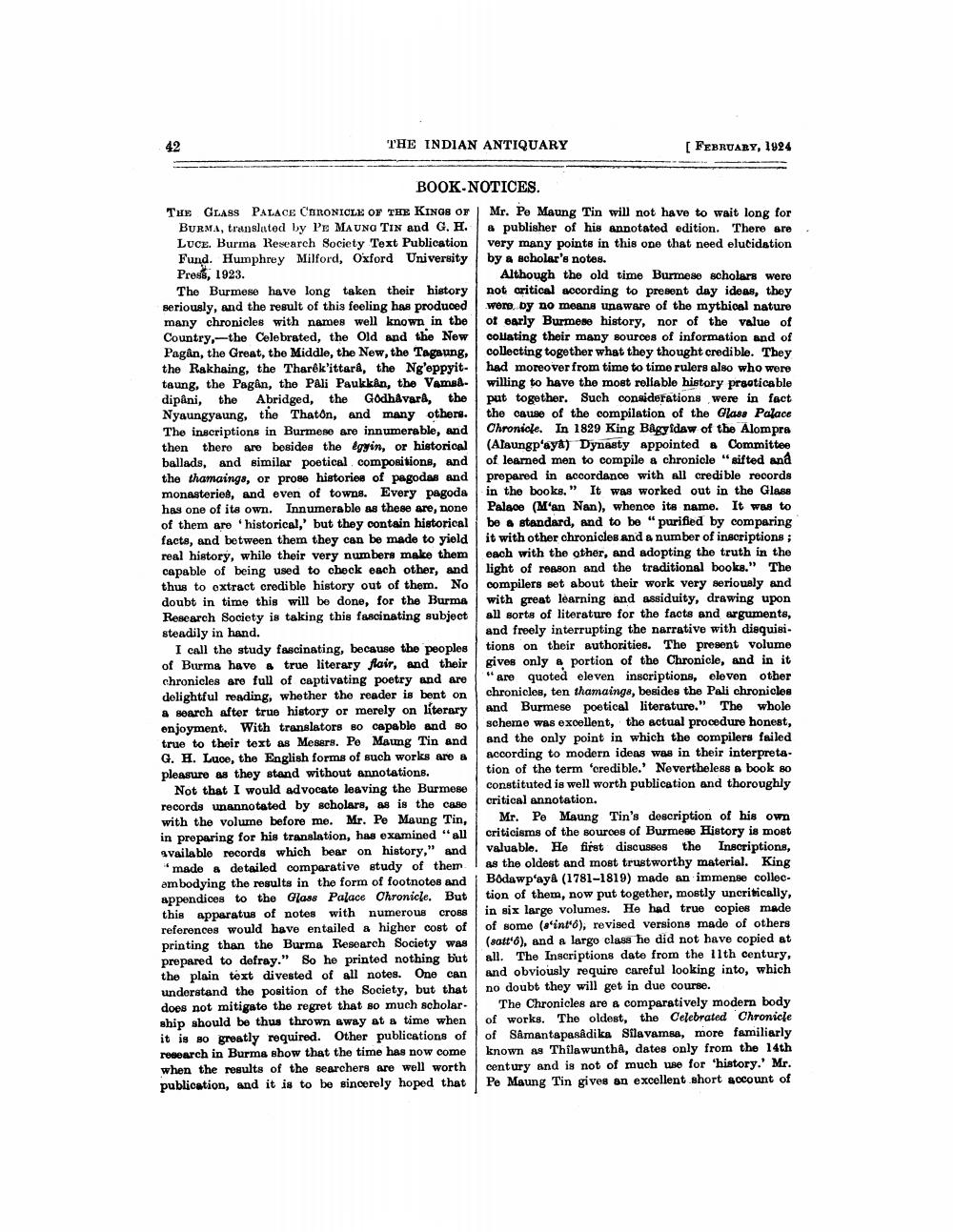________________
THE INDIAN ANTIQUARY
[ FEBRUARY, 1924
BOOK-NOTICES. THE GLASS PALACE CHRONICLE OF THE KINGS OF Mr. Pe Maung Tin will not have to wait long for
BURMA, translated by PE MAUNG TiN and G. H. & publisher of his annotated edition. There are LUCE. Burma Research Society Text Publication very many points in this one that need elucidation Fund. Humphrey Milford, Oxford University by a scholar's notes. Press, 1923.
Although the old time Burmese scholars were The Burmese have long taken their history not critical according to present day ideas, they seriously, and the result of this feeling has produced were, by no means unaware of the mythical nature many chronicles with names well known in the of early Burmese history, nor of the value of Country,-the Celebrated, the old and the New collating their many sources of information and of Pagân, the Great, the Middle, the New, the Tagaung, collecting together what they thought credible. They the Rakhaing, the Tharêk'ittara, the Ng'oppyit- had moreover from time to time rulers also who were toung, the Pagan, the PAli Paukkan, the Vamalwilling to have the most reliable history practicable dipani, the Abridged, the GodhAvara, the put together. Such considerations were in fact Nyaungyaung, the Thaton, and many others. the cause of the compilation of the Class Palace The inscriptions in Burmese are innumerable, and Chronicle. In 1829 King Bagy idaw of the Alompra then there are besides the egyin, or historical (Alsungp'syk) Dynasty appointed & Committee ballads, and similar poetical compositions, and of learned men to compile a chronicle "sifted and the thamaings, or prose histories of pagodas and prepared in accordance with all credible records monasteries, and even of towns. Every pagoda in the books." It was worked out in the Glass has one of its own. Innumerable as these are, none Palace (M'an Nan), whence its name. It was to of them are historical, but they contain historical be a standard, and to be "purified by comparing facts, and between them they can be made to yield it with other chronicles and a number of inscriptions ; real history, while their very numbers make them each with the other, and adopting the truth in the capable of being used to check each other, and light of reason and the traditional books." The thus to extract credible history out of them. No compilers set about their work very seriously and doubt in time this will be done, for the Burma with great learning and assiduity, drawing upon Research Society is taking this fascinating subject all sorts of literature for the facts and arguments, steadily in hand.
and freely interrupting the narrative with disquisiI call the study fascinating, because the peoples tions on their authorities. The present volume of Burma have & true literary flair, and their gives only & portion of the Chronicle, and in it chronicles are full of captivating poetry and are "are quoted eleven inscriptions, eleven other delightful reading, whether the reader is bent on chronicles, ten thamainga, besides the Pali chronicles a search after true history or merely on literary and Burmese poetical literature. The whole enjoyment. With translators so capable and so scheme was excellent, the actual procedure honest, true to their text as Messrs. Pe Maung Tin and and the only point in which the compilers failed G. H. Lace, the English forms of such works are & according to modern ideas was in their interpretapleasure as they stand without annotations. |tion of the term 'credible.' Nevertheless a book so
Not that I would advocate leaving the Burmese constituted is well worth publication and thoroughly records unannotated by scholars, as is the case critical annotation. with the volume before me. Mr. Pe Maung Tin, 1 Mr. Pe Maung Tin's description of his own in preparing for his translation, has examined "all criticisms of the sources of Burmese History is most available records which bear on history," and valuable. He first discusses the Inscriptions, ** made a detailed comparative study of them as the oldest and most trustworthy material. King ambodying the results in the form of footnotes and Bodawp'ay (1781-1819) made an immense collec. appendices to the Glass Palace Chronicle. But tion of them, now put together, mostly uncritically, this apparatus of notes with numerous cross in six large volumes. He had true copies made references would have entailed a higher cost of of some (s'into), revised versions made of others printing than the Burma Research Society was (satt'), and a largo class he did not have copied at prepared to defray." So he printed nothing but all. The Inscriptions date from the 11th century, the plain text divested of all notes. One can and obviously require careful looking into, which understand the position of the Society, but that no doubt they will get in due course. does not mitigate the regret that so much scholar. The Chronicles are a comparatively modern body ship should be thus thrown away at a time when of works. The oldest, the Celebrated Chronicle it is so greatly required. Other publications of of Samantapasâdika Silavamsa, more familiarly research in Burma show that the time has now come known as Thilawuntha, dates only from the 14th when the results of the searchers are well worth century and is not of much use for 'history.' Mr. publication, and it is to be sincerely hoped that Pe Maung Tin gives an excellent short account of




